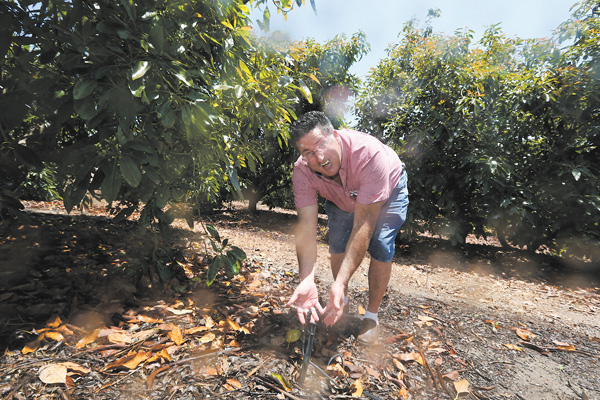Fracking fuels water fights in nation’s dry spots


Farmer David Schwabauer, a fourth-generation avocado and lemon grower, checks an irrigation sprinkler in Moorpark, Calif. The Schwabauer family has been considering allowing energy companies to drill new exploratory wells in their orchards, but the trees in Moorpark rely on irrigation supplies drawn from a depleted aquifer, and the county is in a drought.
Associated Press
SAN FRANCISCO
The latest domestic energy boom is sweeping through some of the nation’s driest pockets, drawing millions of gallons of water to unlock oil and gas reserves from beneath the Earth’s surface.
Hydraulic fracturing, or the drilling technique commonly known as fracking, has been used for decades to blast huge volumes of water, fine sand and chemicals into the ground to crack open valuable shale formations.
But now, as energy companies vie to exploit vast reserves west of the Mississippi, fracking’s new frontier is expanding to the same lands where crops have shriveled and waterways have dried up due to severe drought.
In Arkansas, Colorado, New Mexico, Oklahoma, Texas, Utah and Wyoming, the vast majority of the counties where fracking is occurring are also suffering from drought, according to an Associated Press analysis of industry-compiled fracking data and the U.S. Department of Agriculture’s official drought designations.
While fracking typically consumes less water than farming or residential uses, the exploration method is increasing competition for the precious resource, driving up the price of water and burdening already depleted aquifers and rivers in certain drought-stricken stretches.
Some farmers and city leaders worry that the fracking boom is consuming too much of a scarce resource, while others see the push for production as an opportunity to make money by selling water while furthering the nation’s goal of energy independence.
Along Colorado’s Front Range, fourth-generation farmer Kent Peppler said he is fallowing some of his corn fields this year because he can’t afford to irrigate the land for the full growing season, in part because deep-pocketed energy companies have driven up the price of water.
“There is a new player for water, which is oil and gas,” said Peppler, of Mead, Colo. “And certainly they are in a position to pay a whole lot more than we are.”
In a normal year, Peppler said he would pay anywhere from $9 to $100 for an acre-foot of water in auctions held by cities with excess supplies. But these days, energy companies are paying some cities $1,200 to $2,900 per acre-foot. The Denver suburb of Aurora made a $9.5 million, five-year deal last summer to provide the oil company Anadarko 2.4 billion gallons of excess treated sewer water.
In South Texas, where drought has forced cotton farmers to scale back, water officials said drillers are contributing to a drop in the water table in several areas.
 43
43
